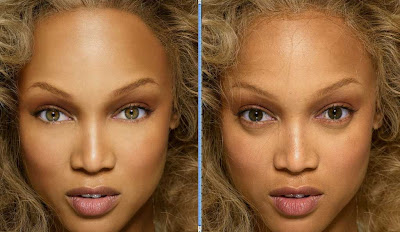Below is a video (from Dove's Campaign for Real Beauty) which demonstrates how much the print media (magazines, billboards, etc.) rely on PhotoShop. It also does a great job of demonstrating why young people today have difficulty living up to the images they see in magazines and advertising. Even supermodels get Photoshopped before they are "good enough".
Here are some examples of Photo Manipulation in the media:

So when did "photo manipulation" begin? Many people think it's a new invention which arrived with the invention of programs like Photoshop, but although technology has made photo manipulation easier it has been around almost since photography was invented. Look at the following examples:
This well-known portrait of Abraham Lincoln was done around 1860. It is actually a combination of Abraham Lincoln's head and Southern politician John Calhoun's body.
This well-known picture of General U.S. Grant atop his horse at a Civil War camp is actually a composite of three separate pictures. (Click to view larger picture)
The big question is to decide when it is appropriate to manipulate a photo and how much manipulation should be done. Are you removing a pimple from the tip of someones nose or doctoring a photo to make someone appear more guilty? Are you removing a power line or a distracting road sign to improve the image, or are you removing wrinkles from someones' face for an anti-wrinkle cream? Here are some more examples:
Click to enlarge.
Click to enlarge.
Another big question is should the news be able to create images to illustrate their stories? Sometimes they are altered, sometimes cropped, and sometimes created outright. So when is something "news" and when does it cross the line to become entertainment?
These two magazine covers used the same photo and sat on news stands the same week:
The same two magazines had these covers depicting the McCaughey septuplets. One magazine (in this case, Newsweek) decided that they needed to replace Mrs. McCaughey's mouth with another that was more attractive.
Sometimes the same company can release the same picture -- and decide to "fix" it.
Here are some examples of when the news takes things out of [or put things into] the picture:
Another big question is should the news be able to create images to illustrate their stories? Sometimes they are altered, sometimes cropped, and sometimes created outright. So when is something "news" and when does it cross the line to become entertainment?
These two magazine covers used the same photo and sat on news stands the same week:
The same two magazines had these covers depicting the McCaughey septuplets. One magazine (in this case, Newsweek) decided that they needed to replace Mrs. McCaughey's mouth with another that was more attractive.
Sometimes the same company can release the same picture -- and decide to "fix" it.
Here are some examples of when the news takes things out of [or put things into] the picture:
 |
| Iranian Missile Launch Test |
The $2 Bill was changed to reflect ethnic diversity in 2009.
When an actor is known for his facial expressions (including wrinkles) it seems silly to Photoshop them out.
Here's an example of the same student from the same picture using 3 different laptops from 3 different advertisements.
In this example, National Geographic gained some dubious recognition when they "created" the cover of the magazine by Photoshopping together pyramids into a more aesthetically pleasing photo.
 |
| These photos of deceased soldiers (released by the Army in 2008) were later retracted when it was discovered that they were identical -- with the exception of the name and face, obviously. |
 |
| Israeli newspaper Yated Neeman removed two female cabinet members from a photo of Prime Minister Netanyahu and President Shimon Peres -- and replaced them with male cabinet members. |
 |
| Malaysian President Jeffrey Wong Su En produced this doctored photo as evidence that he had been knighted by the Queen of England. |
 |
| Egypts newspaper Al-Ahram published this photo in which Egyptian President Mubarak was moved to the leadership position appearing to lead the group of world leaders. |
 |
| Claiming a Rabbinical modesty code, Orthodox newspaper Der Tzitung removed pictures of women from this photo of President Obama's situation room during the take-down of Osama Bin Laden. |
Sometimes they simply piece together parts of the same celebrity to create the shot they are looking for.
There's a quickly growing collection of "Photoshop Fails" which display examples bad Photoshop work -- typically unfinished or unnoticed problems. Usually just the result of lazy designers.
d





















































No comments:
Post a Comment